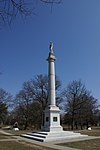Battle of Red Bank
1777 in New Jersey1777 in the United StatesAmerican Revolutionary War sitesBattles involving Great BritainBattles involving Hesse-Kassel ... and 5 more
Battles involving the United StatesBattles of the American Revolutionary War in New JerseyConflicts in 1777Gloucester County, New JerseyPages with missing ISBNs

The Battle of Red Bank was a battle fought on October 22, 1777 during the American Revolutionary War in which a British and Hessian force was sent to take Fort Mercer on the left bank (or New Jersey side) of the Delaware River just south of Philadelphia, but was decisively defeated by a far inferior force of Colonial defenders. Although the British did take Fort Mercer a month later, the victory supplied a sorely-needed morale boost to the American cause, delayed British plans to consolidate gains in Philadelphia, and relieved pressure on General George Washington's army to the north of the city.
Excerpt from the Wikipedia article Battle of Red Bank (License: CC BY-SA 3.0, Authors, Images).Battle of Red Bank
West Military Drive,
Geographical coordinates (GPS) Address Nearby Places Show on map
Geographical coordinates (GPS)
| Latitude | Longitude |
|---|---|
| N 39.871371 ° | E -75.18941 ° |
Address
Christopher Greene
West Military Drive
08063
New Jersey, United States
Open on Google Maps






